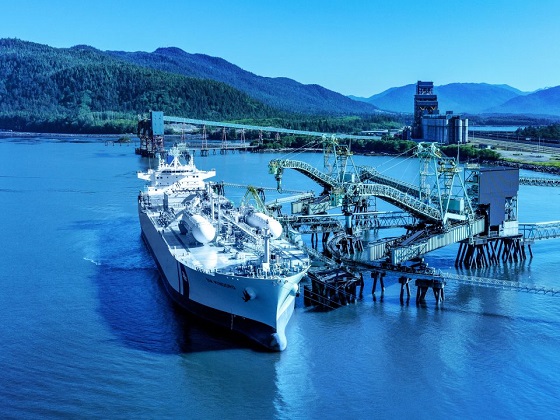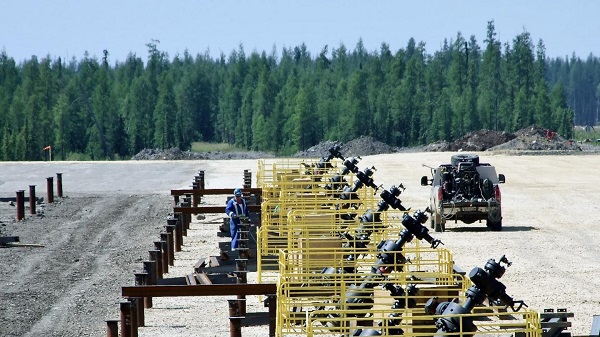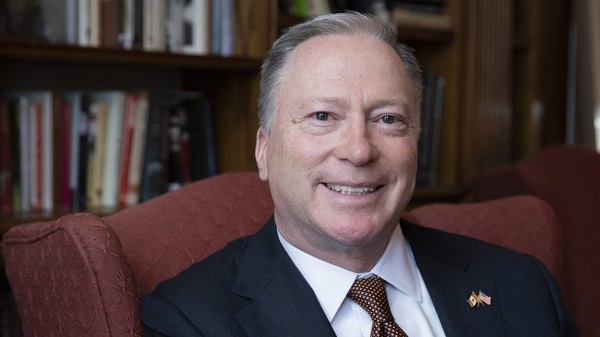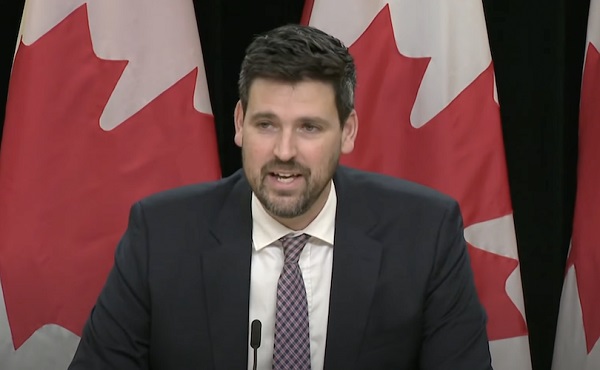Canadian Energy Centre
Canadian renewable propane could be a fuel of the future

From the Canadian Energy Centre
‘We want to make sure we reduce emissions while keeping in mind affordability and reliability’
Four years ago, Craig Timmermans’ two Ontario radio stations became Canada’s first to go on the air from off the grid.
Faced with an $80,000 connection fee and ongoing electricity delivery costs, Timmermans opted for another solution: solar and propane.
“I did our power calculation: five staff, hot water tank, heating system, etc., right down to a coffee maker…then we need a heating source, so it made sense to go with propane,” he said.
“When I looked at all the different heating systems, I found that propane is hands down the most efficient.”
Now Timmermans is building a new home that will run exclusively on propane. He says he wanted propane appliances due to their efficiency.
Ontario radio operators KT and Craig Timmermans power their off-grid business with propane and solar. Photo supplied to the Canadian Energy Centre
“A propane cooking stove is the best cooking appliance…The heat is continuous, it’s instant. It just works so well.”
Lower environmental footprint
Propane serves many purposes in Canada, from supporting mining and oil and gas operations to fueling heating, cooling, cooking and power in remote, off-grid communities.
In these communities, propane can replace diesel with a lower environmental footprint. Propane’s carbon intensity is estimated at 72 grams of CO2 equivalent per megajoule, compared to 100 grams for diesel.
That could be slashed by more than half with a move to renewable propane, according to the Canadian Propane Association (CPA). The CPA has commissioned a new report that looks at potential pathways to producing renewable propane in Canada.
 Propane storage tank. Getty Images photo
Propane storage tank. Getty Images photo
Pairing with heat pumps and hybrid energy systems
The report serves as the foundation of the CPA’s roadmap for scaling up renewable propane production in Canada.
The CPA says the fuel is ideal for pairing with electric heat pumps to provide back-up heat in low temperatures, especially in remote regions that are not near natural gas grids.
It’s also promising for hybrid systems where solar or wind provides baseload energy and renewable propane provides support when renewables are not available.
Part of propane’s appeal – renewable or otherwise – is that it’s easily liquefied and stored in pressurized cylinders, making it a versatile energy source used almost anywhere, the CPA says.
“We want to make sure we reduce emissions while keeping in mind affordability and reliability as key pillars in any energy transformation,” said CEO Shannon Watt.
“Propane goes where other fuels can’t go.”
Producing renewable propane
Today, most propane produced in Canada comes as a byproduct from natural gas processing.
Among other sources, renewable propane can be co-produced with renewable diesel and sustainable aviation fuel, made primarily from plant and vegetable oils, animal fats or used cooking oil.
Cost is the barrier to renewable propane production – about double what it takes to produce conventional propane, the CPA says.
The United States is offering incentives for renewable propane that are not available in Canada.
Through the Inflation Reduction Act, Renewable Fuel Standard and Low Carbon Fuel Standard, renewable propane producers can receive C$20 per gigajoule (or more than C$30 per GJ in California).
Through Canada’s Clean Fuel Regulations, the incentive is just over C$5 per GJ, or about C$10 per GJ in British Columbia.
“In order to attract investment the same way as the U.S. under the Inflation Reduction Act, we need to have competing measures in place,” Watt said.
“We’ve got the technology and we’ve got the feedstocks. We’ve got a lot of those big puzzle pieces that we need. Now we need the dollars to flow.”
 The Ridley Island Export Terminal in Prince Rupert, B.C. ships Canadian propane to overseas markets. Photo courtesy AltaGas
The Ridley Island Export Terminal in Prince Rupert, B.C. ships Canadian propane to overseas markets. Photo courtesy AltaGas
Exporting renewable propane to the world
A large-scale renewable propane industry wouldn’t just benefit Canadians, she said.
That’s because global demand for propane is growing.
Market research firm IMARC Group projects world propane use will rise to nearly 250 million tonnes by 2032, more than one-third higher than demand last year.
The transition to cleaner energy sources is a major factor propelling growth, analysts said.
Until recently, Canada’s only propane exports went to the United States. That changed with the startup of two export terminals at Prince Rupert, B.C.
Since 2017, Canada’s propane exports outside the U.S. have grown substantially, reaching 42 per cent of total propane exports in 2023, according to the Canada Energy Regulator.
“We export more and more propane to non-U.S. locations,” Watt said.
“Now, roughly 50 per cent of Canadian propane is shipped to South Korea, Japan and Mexico, displacing higher emission intensity sources, namely coal and timber.”
Exporting renewable propane would take the benefits a step further, she said.
“That carries the conversation on about reducing global emissions and not just what’s happening in our own backyard.”
Alberta
Busting five myths about the Alberta oil sands

Construction of an oil sands SAGD production well pad in northern Alberta. Photo supplied to the Canadian Energy Centre
From the Canadian Energy Centre
The facts about one of Canada’s biggest industries
Alberta’s oil sands sector is one of Canada’s most important industries — and also one of its most misunderstood.
Here are five common myths, and the facts behind them.
Myth: Oil sands emissions are unchecked

Steam generators at a SAGD oil sands production site in northern Alberta. Photo courtesy Cenovus Energy
Reality: Oil sands emissions are strictly regulated and monitored. Producers are making improvements through innovation and efficiency.
The sector’s average emissions per barrel – already on par with the average oil consumed in the United States, according to S&P Global – continue to go down.
The province reports that oil sands emissions per barrel declined by 26 per cent per barrel from 2012 to 2023. At the same time, production increased by 96 per cent.
Analysts with S&P Global call this a “structural change” for the industry where production growth is beginning to rise faster than emissions growth.
The firm continues to anticipate a decrease in total oil sands emissions within the next few years.
The Pathways Alliance — companies representing about 95 per cent of oil sands activity — aims to significantly cut emissions from production through a major carbon capture and storage (CCS) project and other innovations.
Myth: There is no demand for oil sands production

Expanded export capacity at the Trans Mountain Westridge Terminal. Photo courtesy Trans Mountain Corporation
Reality: Demand for Canadian oil – which primarily comes from the oil sands – is strong and rising.
Today, America imports more than 80 per cent more oil from Canada than it did in 2010, according to the U.S. Energy Information Administration (EIA).
New global customers also now have access to Canadian oil thanks to the opening of the Trans Mountain pipeline expansion in 2024.
Exports to countries outside the U.S. increased by 180 per cent since the project went into service, reaching a record 525,000 barrels per day in July 2025, according to the Canada Energy Regulator.
The world’s appetite for oil keeps growing — and it’s not stopping anytime soon.
According to the latest EIA projections, the world will consume about 120 million barrels per day of oil and petroleum liquids in 2050, up from about 104 million barrels per day today.
Myth: Oil sands projects cost too much
Reality: Operating oil sands projects deliver some of the lowest-cost oil in North America, according to Enverus Intelligence Research.
Unlike U.S. shale plays, oil sands production is a long-life, low-decline “manufacturing” process without the treadmill of ongoing investment in new drilling, according to BMO Capital Markets.
Vast oil sands reserves support mining projects with no drilling, and the standard SAGD drilling method involves about 60 per cent fewer wells than the average shale play, BMO says.
After initial investment, Enverus says oil sands projects typically break even at less than US$50 per barrel WTI.
Myth: Indigenous communities don’t support the oil sands

Chief Greg Desjarlais of Frog Lake First Nation signs an agreement in September 2022 whereby 23 First Nations and Métis communities in Alberta acquired an 11.57 per cent ownership interest in seven Enbridge-operated oil sands pipelines for approximately $1 billion. Photo courtesy Enbridge
Reality: Indigenous communities play an important role in the oil sands sector through community agreements, business contracts and, increasingly, project equity ownership.
Oil sands producers spent an average of $1.8 billion per year with 180 Indigenous-affiliated vendors between 2021 and 2023, according to the Canadian Association of Petroleum Producers.
Indigenous communities are now owners of key projects that support the oil sands, including Suncor Energy’s East Tank Farm (49 per cent owned by two communities); the Northern Courier pipeline system (14 per cent owned by eight communities); and the Athabasca Trunkline, seven operating Enbridge oil sands pipelines (~12 per cent owned by 23 communities).
These partnerships strengthen Indigenous communities with long-term revenue, helping build economic reconciliation.
Myth: Oil sands development only benefits people in Alberta
Reality: Oil sands development benefits Canadians across the country through reliable energy supply, jobs, taxes and government revenues that help pay for services like roads, schools and hospitals.
The sector has contributed approximately $1 trillion to the Canadian economy over the past 25 years, according to analysis by the Macdonald-Laurier Institute (MLI).
That reflects total direct spending — including capital investment, operating costs, taxes and royalties — not profits or dividends for shareholders.
More than 2,300 companies outside of Alberta have had direct business with the oilsands, including over 1,300 in Ontario and almost 600 in Quebec, MLI said.
Energy products are by far Canada’s largest export, representing $196 billion, or about one-quarter of Canada’s total trade in 2024, according to Statistics Canada.
Led by the oil sands, Canada’s energy sector directly or indirectly employs more than 445,000 people across the country, according to Natural Resources Canada.
Alberta
Enbridge CEO says ‘there’s a good reason’ for Alberta to champion new oil pipeline

Enbridge CEO Greg Ebel. The company’s extensive pipeline network transports about 30 per cent of the oil produced in North America and nearly 20 per cent of the natural gas consumed in the United States. Photo courtesy Enbridge
From the Canadian Energy Centre
B.C. tanker ban an example of federal rules that have to change
The CEO of North America’s largest pipeline operator says Alberta’s move to champion a new oil pipeline to B.C.’s north coast makes sense.
“There’s a good reason the Alberta government has become proponent of a pipeline to the north coast of B.C.,” Enbridge CEO Greg Ebel told the Empire Club of Canada in Toronto the day after Alberta’s announcement.
“The previous [federal] government’s tanker ban effectively makes that export pipeline illegal. No company would build a pipeline to nowhere.”
It’s a big lost opportunity. With short shipping times to Asia, where oil demand is growing, ports on B.C.’s north coast offer a strong business case for Canadian exports. But only if tankers are allowed.
A new pipeline could generate economic benefits across Canada and, under Alberta’s plan, drive economic reconciliation with Indigenous communities.
Ebel said the tanker ban is an example of how policies have to change to allow Canada to maximize its economic potential.
Repealing the legislation is at the top of the list of needed changes Ebel and 94 other energy CEOs sent in a letter to Prime Minister Mark Carney in mid-September.
The federal government’s commitment to the tanker ban under former Prime Minister Justin Trudeau was a key factor in the cancellation of Enbridge’s Northern Gateway pipeline.
That project was originally targeted to go into service around 2016, with capacity to ship 525,000 barrels per day of Canadian oil to Asia.
“We have tried to build nation-building pipelines, and we have the scars to prove it. Five hundred million scars, to be quite honest,” Ebel said, referencing investment the company and its shareholders made advancing the project.
“Those are pensioners and retail investors and employees that took on that risk, and it was difficult,” he said.
For an industry proponent to step up to lead a new Canadian oil export pipeline, it would likely require “overwhelming government support and regulatory overhaul,” BMO Capital Markets said earlier this year.
Energy companies want to build in Canada, Ebel said.
“The energy sector is ready to invest, ready to partner, partner with Indigenous nations and deliver for the country,” he said.
“None of us is calling for weaker environmental oversight. Instead, we are urging government to adopt smarter, clearer, faster processes so that we can attract investment, take risks and build for tomorrow.”
This is the time for Canadians “to remind ourselves we should be the best at this,” Ebel said.
“We should lead the way and show the world how it’s done: wisely, responsibly, efficiently and effectively.”
With input from a technical advisory group that includes pipeline leaders and Indigenous relations experts, Alberta will undertake pre-feasibility work to identify the pipeline’s potential route and size, estimate costs, and begin early Indigenous engagement and partnership efforts.
The province aims to submit an application to the Federal Major Projects Office by spring 2026.
-

 Agriculture1 day ago
Agriculture1 day agoFrom Underdog to Top Broodmare
-

 City of Red Deer2 days ago
City of Red Deer2 days agoCindy Jefferies is Mayor. Tristin Brisbois, Cassandra Curtis, Jaelene Tweedle, and Adam Goodwin new Councillors – 2025 Red Deer General Election Results
-

 Bruce Dowbiggin2 days ago
Bruce Dowbiggin2 days agoIs The Latest Tiger Woods’ Injury Also A Death Knell For PGA Champions Golf?
-

 Alberta2 days ago
Alberta2 days agoAlberta’s licence plate vote is down to four
-

 Health1 day ago
Health1 day agoSovereignty at Stake: Why Parliament Must Review Treaties Before They’re Signed
-

 Censorship Industrial Complex2 days ago
Censorship Industrial Complex2 days agoCanada’s justice minister confirms ‘hate crimes’ bill applies to online content
-

 Business1 day ago
Business1 day ago$15B and No Guarantees? Stellantis Deal explained by former Conservative Shadow Minister of Innovation, Science and Technology
-

 RCMP1 day ago
RCMP1 day agoPolice arrest thieves using garage-door openers to access homes in Vanier, West Park, Anders Park, and Evergreen







